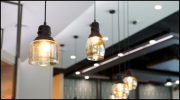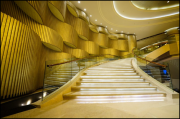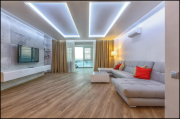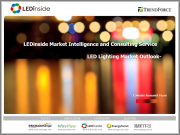
|
시장보고서
상품코드
1671371
세계의 LED 조명 시장 동향 : 데이터베이스 및 진출기업 전략(2025)2025 Global LED Lighting Market Trend- Database and Player Strategies |
||||||
세계의 LED 조명 시장 규모는 일반 조명 시장에서 부정적인 성장을 보이고 있으며 유럽, 미국, 중국 등 주요 지역의 수요 부진으로 인해 마이너스 성장을 경험했으며, 주요 조명 업체들의 전반적인 매출 감소로 이어졌습니다. 반면, LED 스마트 조명과 틈새 시장인 LED 원예 조명 부문은 역성장세를 보였습니다. 2025년까지 LED 일반 조명 시장은 기존 시설의 리노베이션에 따른 LED 교체 수요와 건강하고 쾌적한 스마트 조명 제품뿐만 아니라 고품질 LED에 대한 수요 증가에 힘입어 반등할 것으로 예상됩니다. 한편, LED 원예 조명은 수직 조명의 부활에 힘입어 다음 성장 단계로 진입할 것으로 보입니다.

2024년 시장 규모(단위 : 달러)는 크게 축소되었습니다. 이는 미국 연방준비제도의 지속적인 고금리 정책, 중국의 심각한 디플레이션, 경제 및 지정학적 혼란으로 인한 유럽의 지속적인 약세, 일본의 엔화 약세 영향 등 여러 가지 요인에 기인한 것으로 분석되었습니다. 미국, 유럽, 중국 등 3대 핵심 시장은 오랫동안 조명 수요의 주요 원천이었지만 2024년에는 모두 어려움에 직면하여 전체 LED 조명 시장 가치를 떨어뜨렸습니다. 하지만 4분기에 LED 보급이 가속화되면서 시장 수요가 다소 개선되면서 전체적인 하락세는 다소 완화되었습니다. LED 조명 시장 가치는 4.2% 감소한 560억 5,800만 달러로 집계되었습니다.
2025년에 접어들면서 세계 경제는 완만하게 개선될 것으로 예상됩니다. LED 조명 산업과 밀접한 관련이 있는 건설 부문은 완만한 회복 조짐을 보일 것으로 예상됩니다. 서서히 회복되고 있는 지자체 및 스포츠 부문을 포함한 신규 설치, 리노베이션 프로젝트, 공공 인프라 이니셔티브가 LED 조명 산업을 활성화할 것으로 예상됩니다. 리노베이션이 필요한 기존 시장의 LED 교체 수요와 고품질의 건강하고 편안한 스마트 조명 제품에 대한 수요도 증가할 것으로 예상됩니다. 하지만 글로벌 공급망이 중국에서 벗어나고 글로벌 생산 능력이 지속적으로 확대됨에 따라 경쟁이 심화될 가능성이 높습니다. 또한 2025년에 더 많은 지역에서 보호 관세 제도에 LED 조명을 포함시킬 것으로 예상되며, 특히 미국의 관세 정책이 강화되면서 시장 수요가 억제될 수 있습니다. 전체적으로 TrendForce는 2025년 전 세계의 LED 조명 시장 규모가 566억 2,600만 달러에 달할 것으로 예상합니다. 트렌드포스는 제품 측면에서 인프라, 지자체, 스포츠, 엔터테인먼트 프로젝트에 대한 투자 증가와 전기 자동차 충전소 증가가 실외 조명 부문을 재구성할 기회를 창출할 것이라고 주장합니다. 따라서 LED 가로등, LED 투광 조명, LED 주차장 조명 등 실외 조명 제품은 성장세를 보일 것으로 전망됩니다.
중장기적으로 2026년 이후에는 의료, 첨단 제조, 인프라 등의 부문을 포함한 주거 및 비주거 건설 시장이 LED 조명 산업에서 상당한 성장을 주도할 것으로 예상됩니다. 이러한 성장은 탈탄소화와 같은 지속 가능한 개발 이니셔티브, 건강하고 쾌적한 조명 환경에 대한 소비자 수요 증가, LED 제품의 스마트 제어 시스템으로의 업그레이드에 의해 촉진될 것입니다. 다만, 전 세계적으로 새롭게 부상하는 보호 관세가 수요를 억제할 수 있으므로 주의가 필요합니다. 따라서 트렌드포스는 2024년부터 2029년까지 연평균 2.7%의 성장률로 2029년까지 시장 규모가 639억 3,000만 달러에 달할 것으로 전망하면서 미래를 낙관적으로 내다보고 있습니다.
이 보고서는 세계의 LED 조명 시장에 대해 조사했으며, 시장 개요와 함께 시장 진출기업의 매출 랭킹과 제품 전략, 향후 예측 등을 정리했습니다.
목차
(PDF) 데이터베이스 및 진출기업 전략
제1장 조명 진출기업의 매출 랭킹과 전략
- 조명 산업의 매출과 제품 전략
- Signify
- Zumtobel
- Fagerhult
- Acuity Brands
- Current Lighting Solutions
- Panasonic
- 중국의 조명 제조업체의 매출과 제품 전략
- LEDVANCE/MLS
- Opple Lighting
- NVC Lighting
제2장 LED 조명 시장 역학 월별 보고서
- 서문
- 조명 시장의 주요 조사 결과
- LED 패키지 제조업체의 현황
- 조명 제조업체의 현황
- 조명 정책과 규제의 현황에 관한 최신 정보
- 틈새 조명 시장의 상황에 관한 최신 정보
(EXCEL) 데이터베이스 및 진출기업 전략
제1장 서론
제2장 일반 조명 시장 예측(2025-2029년)
- 일반 LED 조명 시장 규모 : 수요 시장 가치 및 수량과 평균 판매 가격(제품별)
- 일반 LED 조명 시장 규모 : 수요 시장 가치(카테고리별,램프 및 조명기구)
- 일반 LED 조명 시장 규모 : 수요 시장 가치(지역별)
- 일반 LED 조명 시장 규모 : 수요 시장 가치 및 수량(제품별 및 지역별)
- 일반 LED 조명 시장 규모 : 수요 시장 가치(용도)
- 일반 LED 조명 보급률(설치량 기준)
- 일반 LED 조명 시장 : 가치 및 수량(용도별)
- 일반 LED 조명 시장 : 가치, 수량, 평균 판매 가격(전력별)
- 일반 LED 조명 시장 : 패키지 유형별 가치, 수량, 평균 판매 가격
- 일반 LED 조명 시장 가치 : CCT
- 일반 LED 조명 시장 : 가치 및 수량(CRI)
- 일반 LED 조명 가격
제3장 스마트 조명 시장 예측(2025-2029년)
- 스마트 LED 조명 시장 규모 : 수요 시장 가치(용도별)
- 스마트 LED 조명 시장 규모 : 수요 시장 가치(지역별)
제4장 농업용 조명 시장 예측(2025-2029년)
- 원예용 LED 조명 시장 규모 : 수요 시장 가치(용도별)
- 원예용 LED 조명 시장 규모 : 수요시장가치(지역별)
- 농업용 LED 조명 시장 : 칩 유형별 가치 및 수량
- 농업용 LED 조명 시장 : 가치 및 수량(전력별)
- 농업용 LED 조명 가격
- 원예용 LED 조명 참가 기업의 매출 랭킹(2023-2024년)
제5장 조명 업계의 매출 랭킹과 예측
- 상위 20 개 조명 참가 기업 매출(2023-2024년)
- 상위 10 개 조명 참가 기업 매출(2023-2024년), 용도별
- LED 조명 참가 기업의 매출(2023년-2024년)
제6장 LED 조명 제품 사양 및 가격
HBR 25.03.18According to the latest TrendForce report "2025 Global LED Lighting Market Trend- Database and Player Strategies", in 2024, the LED general lighting market experienced negative growth as sluggish demand in key regions across Europe, the United States, and China weighed on performance, leading to overall revenue declines among leading lighting companies. In contrast, the LED smart lighting and niche LED horticultural lighting segments showed countertrend growth. Toward 2025, the LED general lighting market is expected to rebound, driven primarily by the demand for LED replacements during renovation of existing installations and by the increasing demand for high-quality LEDs as well as healthy, comfortable, and smart lighting products. Meanwhile, LED horticultural lighting is poised to enter its next growth phase, fueled by a resurgence in vertical.
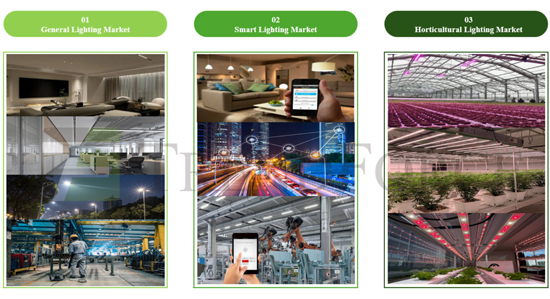
General Lighting Market
According to TrendForce analysis, in 2024 the market size measured in USD contracted significantly. This was primarily due to several factors: the US Federal Reserve's continued high interest rate policy, severe deflation in China, persistent weakness in Europe amid economic and geopolitical turmoil, and the impact of yen depreciation in Japan. The three core markets-the US, Europe, and China-have long been the main sources of lighting demand, but all faced challenges in 2024 that dragged down overall LED lighting market value. However, as market demand improved somewhat in 4Q24 with accelerating LED penetration, the overall decline was slightly mitigated. The LED lighting market value fell by 4.2% to USD 56.058 billion.
Entering 2025, the global economy is expected to improve moderately. The construction sector-closely linked to the LED lighting industry-is projected to show signs of a gentle recovery. New installations, renovation projects, and public infrastructure initiatives, including those in the slowly recovering municipal affairs and sports segments, are anticipated to boost the LED lighting industry. The demand for LED replacements in existing markets requiring renovations, as well as that for high-quality, healthy, comfortable, and smart lighting products, are expected to rise. That being said, as the global supply chain shifts away from China and global production capacity continues to expand, competition is likely to intensify. In addition, more regions are expected to include LED lighting within their protective tariff schemes in 2025-particularly with intensified US tariff policies-which could suppress market demand. Overall, TrendForce estimates the global LED lighting market size to positively return to USD 56.626 billion in 2025.
From the product perspective, TrendForce maintains that increased investments in infrastructure, municipal affairs, sports, and entertainment projects, along with a rising number of electric vehicle charging stations, will create opportunities to reconfigure the outdoor lighting sector. Therefore, outdoor lighting products-including LED street lights, LED floodlights, and LED parking lot lights-are forecast to witness an upward growth trend.
In the mid-to-long term, beyond 2026, the residential and non-residential construction markets-including segments such as healthcare, advanced manufacturing, and infrastructure-are expected to drive significant growth in the LED lighting industry. This growth will be fueled by sustainable development initiatives like decarbonization, increasing consumer demand for healthy and comfortable lighting environments, and the upgrade of LED products to smart control systems. However, caution is advised as emerging protective tariffs worldwide could suppress demand. Consequently, TrendForce remains cautiously optimistic about the future, forecasting the market size to reach USD 63.903 billion by 2029, with a CAGR of 2.7% from 2024 to 2029.
Smart Lighting Market
In 2024, driven by the demand for energy savings, LED lighting products have increasingly incorporated dimming, color tuning, and smart control systems. According to the latest data from TrendForce, the global smart lighting market size grew by 17.6% in 2024.
Broken down by application, the growth was primarily driven by lower costs of smart lighting products and steadily increasing energy-saving demand in the professional lighting market (including commercial, outdoor, and industrial segments) which spurred growth in IoT lighting, particularly in the outdoor and industrial sectors. In 2025, improved consumer demand is expected to stimulate a rebound in smart household lighting, covering products such as bulbs, filament lamps, and ceiling lights. Additionally, spotlights, downlights, and LED strips are gradually penetrating the smart household lighting market, experiencing rapid growth.
Horticultural Lighting Market
According to the latest data from TrendForce, the global LED horticultural lighting market size reached USD 1.315 billion in 2024, reflecting a year-on-year growth of 6.6%. TrendForce's analysis indicates that this recovery is not simply due to downstream restocking; rather, it represents a genuine and sustainable resurgence in demand.
Forecasting for 2025, a new round of cannabis lighting replacements is expected. During the peak period of cannabis applications in 2020-2021, the lighting solutions used featured lower lifespans, luminous efficacy, and light intensity. The anticipated transition to products with higher photosynthetic photon flux (PPF) and photosynthetic photon efficacy (PPE), as well as dimmable multi-channel models, is expected to stimulate further demand. Additionally, ongoing LED penetration to replace traditional high-energy-consuming products, combined with renewed heavy investments in vertical farming across Asia, the Middle East, North America, and Europe-where crop varieties are diversifying towards higher-value produce and research institutions are intensifying their involvement-will inevitably drive rapid growth in the LED horticultural lighting market.
Strategies from Lighting Companies
According to TrendForce, the global lighting market demand remained weak in 2024, especially due to sluggish new installations. Aside from a few companies that have managed to grow revenue through unique operating strategies, most firms experienced varying degrees of decline due to weak revenue. European and the US brands, in particular, suffered from project suspensions or delays, which further deepened their revenue falls; meanwhile, Chinese OEMs faced fierce competition as both shipments and prices dropped. The top 20 lighting companies achieved a combined revenue of USD 24.134 billion in 2024-a 4.7% year-on-year decline that continues a downward trend. Nevertheless, the ranking of the top five remained unchanged, namely Signify, Acuity Brands, Panasonic, LEDVANCE/MLS Lighting, and Zumtobel, reflecting a stable industry structure.
TrendForce further analyzes that the lighting market is mature, highly fragmented, and extremely competitive, making economies of scale particularly important. Additionally, niche lighting segments with relatively high barriers-such as horticultural lighting, marine lighting, and healthcare lighting-are emerging as key areas for future competition and market penetration. For example, the North American leader Acuity Brands is actively entering the gas station lighting market, which it had not previously explored, in an effort to capture additional market share. This indicates that resources will increasingly concentrate on larger companies, leading to a "big gets bigger" trend. Furthermore, digital transformation continues to be a focus for companies, and the integration of LED lighting with smart control systems is expected to be widely adopted, thus unlocking new opportunities for second-round replacement demand growth.
Table of Contents
[PDF] Database and Player Strategies
1. Lighting Player Revenue Ranking and Strategies
- Lighting Player Revenue and Product Strategies
- Signify
- Zumtobel
- Fagerhult
- Acuity Brands
- Current Lighting Solutions
- Panasonic
- Chinese Lighting Player Revenue and Product Strategies
- LEDVANCE / MLS
- Opple Lighting
- NVC Lighting
2. LED Lighting Market Dynamics Monthly Report
- Foreword
- [TrendForce's Prospective] Key Findings in Lighting Market
- Updates on Statuses of LED Package Manufacturers
- Updates on Statuses of Lighting Manufacturers
- Updates on Statuses of Lighting Policies and Regulations
- Updates on Niche Lighting Market Statuses
[EXCEL] Database and Player Strategies
1. Introduction
- 1.1. Market Research Methodology NEW
- 1.2. Global Economics (GDP) NEW
- 1.3. Exchange Rates NEW
2. General Lighting Market Forecast (2025-2029)
- 2.1. General LED Lighting Market Scale-Demand Market Value & Volume & ASP-by Product
- 2.2. General LED Lighting Market Scale-Demand Market Value-by Category-Lamps & Luminaries
- 2.3. General LED Lighting Market Scale-Demand Market Value-by Region
- 2.4. General LED Lighting Market Scale-Demand Market Value & Volume-by Product & by Region
- 2.5. General LED Lighting Market Scale-Demand Market Value-by Application
- 2.6. General LED Lighting Penetration Rate (Installed Based Volume)
- 2.7. General Lighting LED Market-Value & Volume-by Application
- 2.8. General Lighting LED Market-Value & Volume & ASP-by Power
- 2.9. General Lighting LED Market-Value & Volume & ASP-by Package Type
- 2.10. General Lighting LED Market-Value-by CCT NEW
- 2.11. General Lighting LED Market-Value & Volume-by CRI NEW
- 2.12. General Lighting LED Price
3. Smart Lighting Market Forecast (2025-2029)
- 3.1. Smart LED Lighting Market Scale-Demand Market Value-by Application NEW
- 3.2. Smart LED Lighting Market Scale-Demand Market Value-by Region NEW
4. Agricultural Lighting Market Forecast (2025-2029)
- 4.1. Horticultural LED Lighting Market Scale-Demand Market Value-by Application
- 4.2. Horticultural LED Lighting Market Scale-Demand Market Value-by Region
- 4.3. Agricultural Lighting LED Market-Value & Volume-by Chip Type NEW
- 4.4. Agricultural Lighting LED Market-Value & Volume-by Power NEW
- 4.5. Agricultural Lighting LED Price
- 4.6. Horticultural Lighting LED Player Revenue Ranking (2023-2024) NEW
5. Lighting Player Revenue Ranking and Estimated
- 5.1. Top 20 Lighting Player Revenue (2023-2024)
- 5.2. Top 10 Lighting Player Revenue Ranking by Application (2023-2024) NEW
- 5.3. Lighting LED Player Revenue (2023-2024) NEW
6. LED Lighting Product Specification and Price
- 6.1. Product & Price-Filament Lamp-by Region
- 6.2. Product & Price-Street Light-by Region
- 6.3. Product & Price-Panel Light-by Region
- 6.4. Product & Price-Troffer-by Region
- 6.5. Product & Price-High/Low Bay-by Region
- 6.6. Product & Price-Explosion Proof Light-by Region
- 6.7. Product & Price-Horticultural Light-by Application NEW






